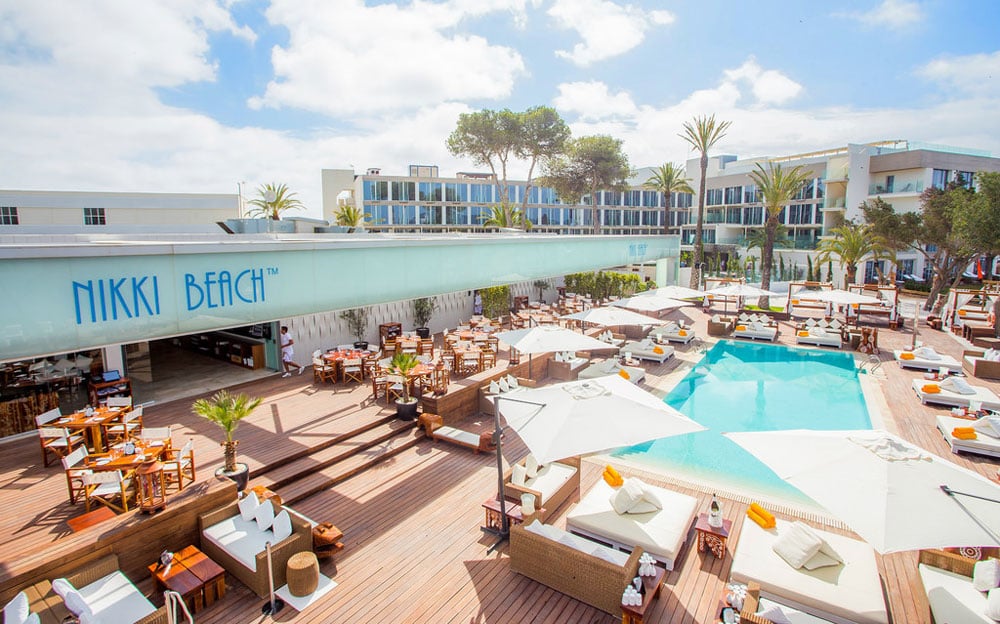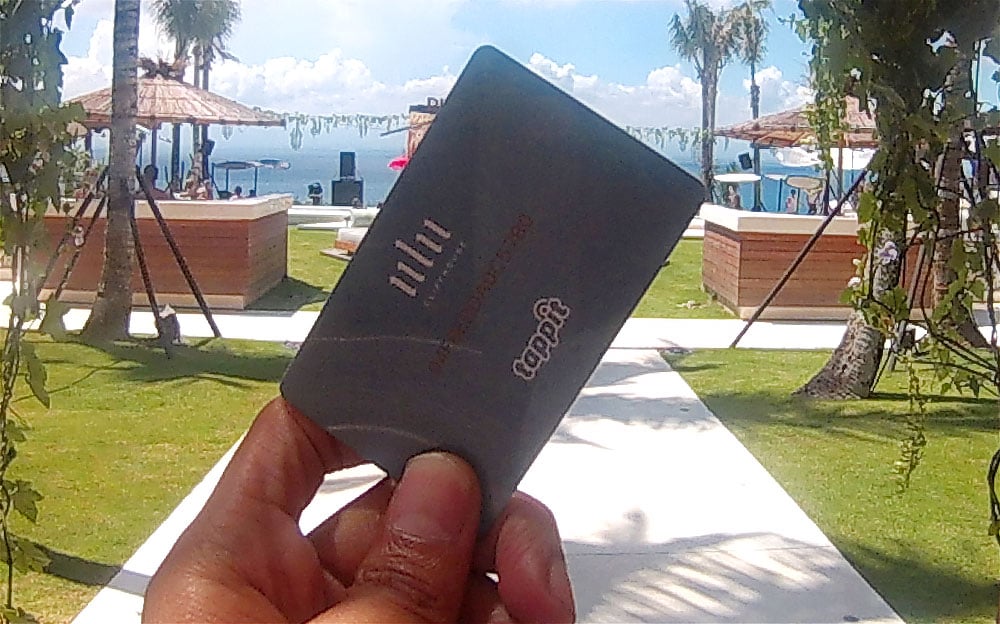Long gone are the days when beach clubs consisted of a neat row of loungers by the seaside or arranged around a pool. To seduce an international, connected and increasingly demanding clientele, the world’s most successful beach clubs are investing in three core strategies, not exclusive of each other: strong branding, conceptualisation and innovation.
Branding
To create a strong brand, an organisation needs to foster an emotional response from its customers. A brand is the specific experience an individual connects with an organisation that distinguishes it from competitors. This is why the ‘story’ behind a beach club has become as important as its service, facilities or location to attract new customers and retain existing ones. A beach club’s narrative needs to be carefully crafted and constantly cultivated.

One of the strongest brands in the sector that immediately evokes ‘beach club’ is Nikki Beach. 2018 marked the 20th anniversary of the brand launched by Jack Penrod as a tribute to the 18-year-old daughter he tragically lost in an accident.
With a motto of ‘Celebrating Life’, Nikki Beach pioneered the luxury beach club concept, with a unique combination of music, dining, entertainment, fashion, film and art into one experience – the six core elements that still define the brand today and reflect the “joyous and infectious spirit” of the founder’s late daughter.
Grown mainly through word of mouth, the strength of its brand has allowed Nikki Beach to become a global, multifaceted luxury lifestyle and hospitality company, which today owns beach clubs all over the world – from Miami and Saint Tropez to Marbella and Koh Samui, but also hotels, resorts, and even a lifestyle and a special events division. The management says it adheres to high standards of integrity and values to protect its image.
“We are seeing many hospitality companies lowering their standards to hold their profit margins, and thinking the customers will not know,”
Thomas Brosig, President of the group, said in an interview with Hotel Business*.
“They are wrong — the customers always know. Our efforts focus on customer retention and customer loyalty through multi-location visits within the same season.”
Beltrán Álvarez de Estrada, CEO of Spain’s Puro Group, which owns several clubs in Europe and America, believes strong brands offer a crucial competitive advantage that is essential in attempts to capture new markets.
“The world is lacking good brands. A lot of hotel companies are looking for new, exciting brands that they can use to attract clients,”
he said in an interview with hosco.tv**.
*https://www.hotelbusiness.com/nikki-beach-plans-growth-amid-commitment-to-its-core-tenets/
**https://www.hosco.com/en/advice/video/how-to-develop-a-beach-club-brand
Conceptualisation & Differentiation
Conceptualisation focuses on offering a new type of customer experience. It’s all about creating a unique atmosphere, powerful aesthetics or a unique approach to create an experience that clients will seek or remember – thanks to the décor, the offering, the ethos or whatever else allows the clubs to make a long-lasting emotional impact on their customers.
One example is Scorpios Mykonos, located on the beach of Paraga, south of the Greek island. Voted one of the world’s best beach clubs by Condé Nast Traveller, the ‘Boho chic’ club boasts a strong visual identity created by Berlin-based ‘designer of the moment’ Annabell Kutucu. The space is characterised by a minimalistic design with natural white and grey elements reminiscent of “1960’s Greek glamour and contemporary modernism”. The overall feeling is sensual, carefree and light.
“Scorpios Mykonos is the celebration of traditional craftsmanship, organic materials and a bohemian-style interior design, presenting a tactile laid-back luxury atmosphere,”
the designer said*. The beach club has successfully captured the spirit of the artist, which is omnipresent.
Differentiation is also an increasingly popular strategy to target particular segments of the market, especially as customers divide themselves into ‘tribes.’ The emphasis on sustainability, wealth and wellness has created opportunities for beach clubs to target customers with a health or eco-conscience, for instance.
The promise of the Papaya Playa Beach Club in Tulum, Mexico, is to offer “a new form of hospitality”. The club’s vision is to merge local culture and sustainability to create “an original and aspirational hospitality experience”**. Its eco-credentials are strong. The club has a ‘zero emissions’ and ‘zero contamination’ objective it fulfils using solar power and through its minimal use of chemicals. Its social credentials are equally as impressive as the club thrives to build strong links with local communities. The ‘kids on the beach’ project, for example, aims at encouraging customer interaction with children from nearby Mayan village. The club also offers a plethora of holistic activities to provide a relaxing environment nurturing physical and emotional wellness.
*https://annabellkutucu.com/scorpios-mykonos
**https://www.papayaplayaproject.com/
Digital innovation

Digital payments, using Big Data to get customer insight and personalise offers, apps to improve service or social media for recruitment: the beach club industry’s digital transformation is in full swing. In an industry ripe for disruption, tomorrow’s big winners are using innovation to improve their customers’ experience and remove friction for a smooth experience.
Ulu Cliffhouse, one of Bali’s newest beach clubs, is one of those clubs. It has switched to cashless payments to create an environment where, from arrival to departure, a guest can enjoy freedom of movement without stop points and checkpoints.
“Operating a big space and having a setup that allows guests to move freely around the venue, without the burden of carrying cash, especially when wearing swimwear, or needing to identify their table, booking name, etc., allows for a much freer experience, in keeping with the brand,”
explains Jacques Dejardin, the club’s director.
Hillside Beach Club on Turkey’s Turquoise coast is another example. A few years ago, the group launched a mobile app so that customers can get refreshments almost instantly. Its Beach Order App allows visitors to order a drink by indicating your umbrella number so that drinks can then be delivered within minutes. Customers can also view the photos, ingredients and prices of the beverages on the app, while a ‘notes’ section makes it possible for them to personalise their drink to their taste.
Hillside Beach Club has also extensively used social media to create new experiences for customers. It has installed Instagram points throughout the resort, for instance, to recommend the best places to take a selfie. Hillside was actually the first club in the world to do recruitment via the platform. Its “Chief Instagram Officer” (“CIO”) project, launched in 2015, consisted of asking people to share summer holiday photos on Instagram with the ‘Job @ Heaven on Earth’ tag.
After receiving over 50 thousand submissions and reaching 23.5 million users, the club selected six CIOs from around the world to experience Hillside Beach Club and manage the hotel’s Instagram account for one week. The campaign won ‘Most successful project’ of Social Media Campaigns at the 14th Golden Spider Web Awards. It was even used as a case study by Harvard Business School* to “challenge the students to ponder what it takes for a company to repeatedly increase customer satisfaction rates and profitability with the same product over the years.”
*https://www.hbs.edu/faculty/Pages/item.aspx?num=51092
While some people are having the best holiday ever at these clubs, it’s clear that innovation and differentiation never stops and by embracing these trends, beach clubs and hospitality businesses can achieve incredible success.



COMMENTS